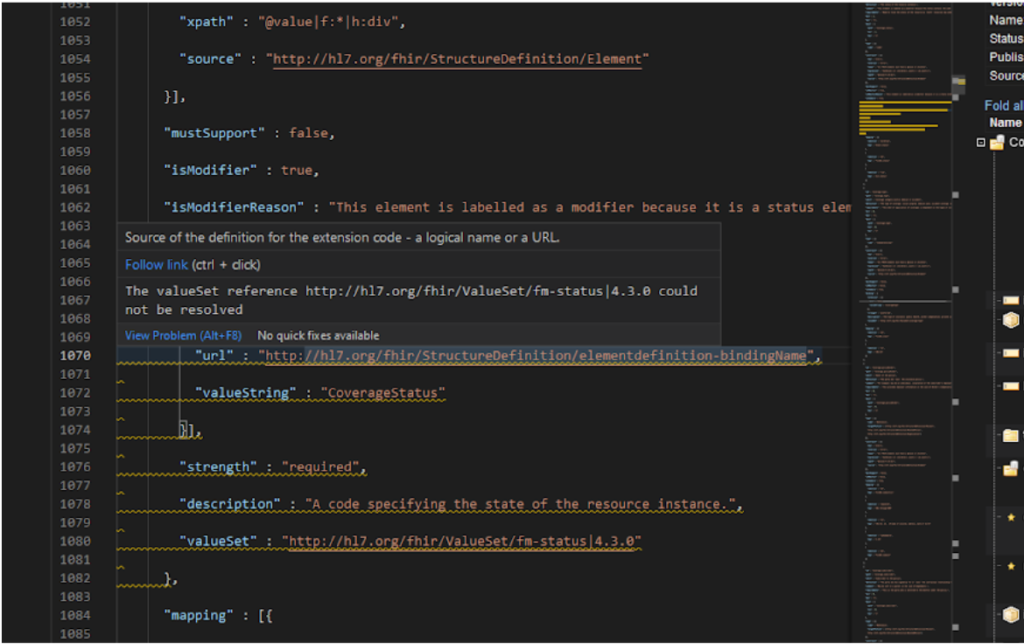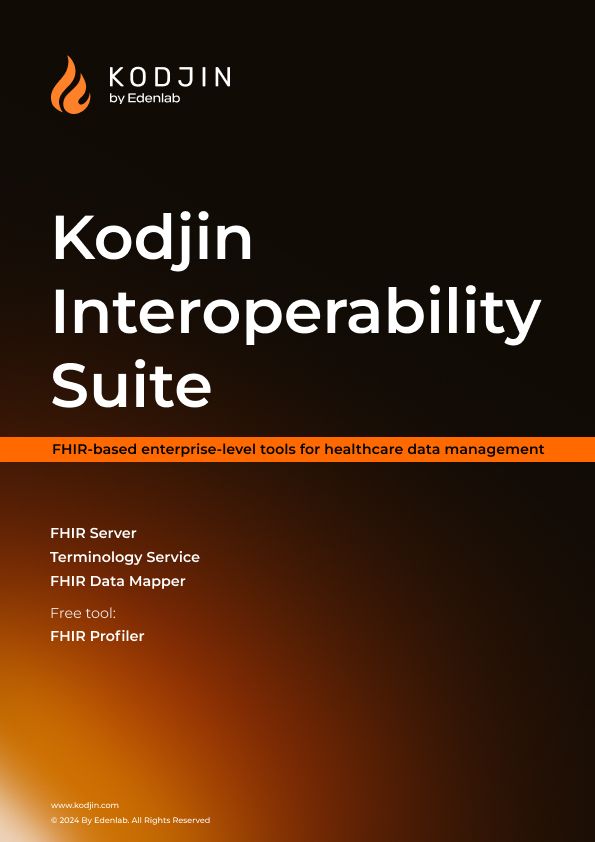The Fast Healthcare Interoperability Resource (FHIR®) is a data standard developed by HL7 International with the complexity of healthcare data in mind. It facilitates the FHIR bulk data export, exchange and interoperability of healthcare information between different IT systems.
In this article, we’ll examine some of the most popular FHIR profile editors and compare their functionality, so you can choose the best FHIR profiling tool that will best fit your needs. But first, let’s take a look at what profiling entails.
How does profiling work?
The philosophy behind FHIR® is to build a set of common resources that can be tweaked to tailor to the needs of most healthcare organizations. The FHIR resources are defined very loosely to provide room for flexibility. For example, the resource Patient covers demographic and administrative data about a person or animal receiving care.
The resources can cover different aspects of the healthcare domain, from scheduling and patient management to medical billing and information tracking. The native data elements in an FHIR resource are intended to cover most use cases.
But each case of FHIR® implementation is unique, and so are the resource use cases. FHIR profiles allow you to customize resource definitions by constraining which elements of a resource are required and which are not. Profiling helps define the missing extensions that should be added and how API functions and terminologies should be used (terminologies in FHIR® are defined using value sets and code systems).
This necessary process of tweaking FHIR resources is referred to as profiling. You can either restrict or expand the requirements for the resource depending on the needed context. Implementation guides with structure definitions are used to validate resources so that they match.
How FHIR profiling tools help developers
FHIR profiling tools such as Kodjin Profiler Tool, Forge, and Trifolia can help developers to create custom FHIR profiles that meet the specific needs of healthcare applications.
Typically healthcare analysts have to manually edit JSON files directly in text editors or IDEs (Integrated Development Environment) such as Visual Studio Code. This creates a high skill barrier for profile creation, as well as leads to a number of difficulties with code validation, correct profile structure, and poor time efficiency. Each resource property has to be specified separately, leaving room for human error.
A few FHIR profile creation tools are available on the market to solve these issues; we’ve tried some of the best FHIR profiling tools and analyzed the pros and cons of each solution.
Best FHIR data profiling tools list
- Kodjin Profiler Tool
- The Forge from Fire.ly
- Trifolia-on-FHIR
See more details about FHIR profiling tools for developers below.
Kodjin Profiler Tool – Best FHIR Profiling Tool
Kodjin Profiler is a profile editing tool that automates many of the core tasks of authoring profiles and allows users to create a visual resource tree structure. Kodjin Profiler comes both in a web version as well as a Visual Studio Code plugin. It’s easily integrated into the Git version control system and can be run out of the box.
Kodjin Profiler is easy to set up; you need only open it and add your profile to start editing. You can also work with multiple files at once. In the web version, the profiles are stored in a local cache, and we can download them. For the VS code plugin, we can store files on a local PC or Github. For those interested in integrating genomic data within the FHIR framework, our FHIR genomics complete guide provides comprehensive insights into this specialized area.
As shown in the screenshots below, the FHIR profiling tool provides different tabs for differential and snapshot views of the profile.
Differential view of the profile
Snapshot view of the profile
The validation is performed by making a snapshot of the structure definition and sending it through the Kodjin FHIR Server. The editor will highlight the code with an error and provide a report, as demonstrated in the screenshot below.

Pros:
- Web + VSCode plugin versions
- No registration required
- Snapshot generation from the differential
- Validation
- Resource tree render
- Supports working with multiple files
- Option to download files
- Tabs for differential and snapshot
Read Also: Healthcare Data Visualization: Importance, Benefits & Examples
The Forge from Fire.ly
FHIR Forge is one of the most popular FHIR tools for creating and editing FHIR profiles. The Forge Data is a FHIR profile editor developed by the Fire.ly team.The tool bolsters a lot of options for data analysts and healthcare developers to customize their FHIR profiles. The Forge allows you to define formal constraints, data slices, value set bindings, mappings, and derived profiles. It also provides a full (snapshot) or differential type of structure definition as well as structure validation.
To use the Forge FHIR tool, you will need to create an account. It’s free of charge for one user. There’s a subscription fee if you want to collaborate with other people and create multiple accounts or for commercial use. Every time you launch the profiling tool, you have to enter your login details manually; there’s no option for auto-login or saving a password. The Forge login page looks like this.
The Forge tool bolsters an abundance of options for profiling, which are all laid out in front of you. However, this also means that to edit element properties and define resources, you will need to take a lot of steps.
For example, in the screenshot below, to change the cardinality of the serviceType element, we need to click on it, select the cardinality field, enter the required number, or choose from the suggested ones.
There is also no expression-construct or autocomplete for FHIRPath or XPath expressions.
Pros:
- You see what you do; all properties are in front of you
- Validations
- A lot of options for elements
- Snapshot or differential type of structure definition
Cons:
- Microsoft® Windows® only
- Registered users only; paid subscription for commercial use. (free of charge for one user)
- Need to log in every time upon launch
- A lot of steps to define resources (structure definitions, search parameters, concepts) properties.
- Can’t just copy and paste
- Can’t describe just differentials
- Difficult to figure out a target profile without a tree structure
- You need to select each field when editing
Trifolia-on-FHIR
Trifolia-on-FHIR is a resource editor tool that uses an FHIR server natively as its back-end. Users can import any resource in the FHIR specification via drag and drop, copying/pasting FHIR XML and JSON code into the application, or adding content from GitHub. The main goal of the tool is to let you export and prepare files and folders for the Implementation Guide publication. Trifolia also works with the internal in-project published IG.
To start profiling, you will need to sign up. There’s only a web version of the editor; it relies on internet access to work.
Since the key idea of Trifolia is to streamline IG creation, all of its features are tuned for that purpose. You can’t create just a profile at a glance.
In the screenshots below, we’ve demonstrated the steps you’d need to take to create or edit FHIR profiles. The Trifolia profiling tool uses various tabs to navigate the process of the Implementation Guide creation. As shown in the first screenshot, you’ll first have to create an Implementation Guide.
This is the tab for adding new profiles. Once you fill everything out, you can proceed to edit the FHIR profile.
Just like in the Forge, to edit element properties, you’ll have to select each field and edit the values manually.
Since Trifolia allows multiple users to work on the project simultaneously, you can manage the permissions of each user, as shown in the screenshot below.
Pros:
- Create and download a finished Implementation Guide
- Access to all projects in a repository for group access
- Manage user permissions
Cons:
- Only for registered users
- Web only; relies on internet access
- You can’t copy and paste some pieces of code
- Download only the differential part for the structure definition
- Not fully rendered structure definition, just part of the information
- You need to select each field when editing
Comparison Table: Forge vs. Trifolia-on-FHIR vs. Kodjin Profiler
Below is a more convenient comparison of the capabilities and features of the best FHIR profiling tools.
| Category | Item | Forge | Trifolia-on-FHIR | Kodjin Profiler |
| Platform | Web | – | + | + |
| Windows | + | n/a (web only) | + | |
| Mac OS | – | n/a (web only) | + | |
| Linux | – | n/a (web only) | + | |
| Vizualization | Element tree | + | + | ++ |
| Team works | Git | – | – | + |
| Proprietory repository | + | + | – | |
| Editor usability | Copy & Paste | – | – | + |
| Focus on profile differences from base definition | – | – | + | |
| Formats | XLM | + | + | – |
| JSON | + | + | + | |
| Documentation | ++ | + | – | |
| Pricing | paid (free for studying) | free | free |
Takeaway
When choosing an FHIR profiling tool, everyone has their own preferences; what some find inefficient, others find convenient. We tried to stay as unbiased as possible and weigh all the pros and cons of each solution fairly. We hope you will find this analysis useful.
The profiling process requires a deep understanding of the FHIR specification, which can complicate FHIR adoption. Incorporating a FHIR facade can simplify this process by providing a more intuitive interface for FHIR profile management. If you want to create custom FHIR profiles or need help with FHIR implementation, our team of FHIR Business Analysts can help you fill in that skill gap. Contact us to discuss your project and how we can help.
FAQ
What are FHIR profiling tools?
These are software apps that help developers and implementers of FHIR systems to define and manage custom FHIR profiles. These FHIR profiling tools allow users to create profiles that specify how FHIR resources should be structured, constrained, and extended to meet the specific needs of their healthcare applications.
How do FHIR profiling tools promote consistency and interoperability?
The use of these tools can help to promote consistency, interoperability, and reuse of FHIR resources across different healthcare systems and applications. By creating custom profiles that adhere to FHIR standards, developers can ensure that their healthcare apps can communicate and share data effectively with other systems.
Read Also: Mapping Healthcare Data to HL7 FHIR Resources
What should developers consider when choosing and using FHIR profiling tools?
Developers should consider factors such as the complexity of their healthcare application, the level of support provided by the tool, and the level of customization required for their FHIR profiles.







